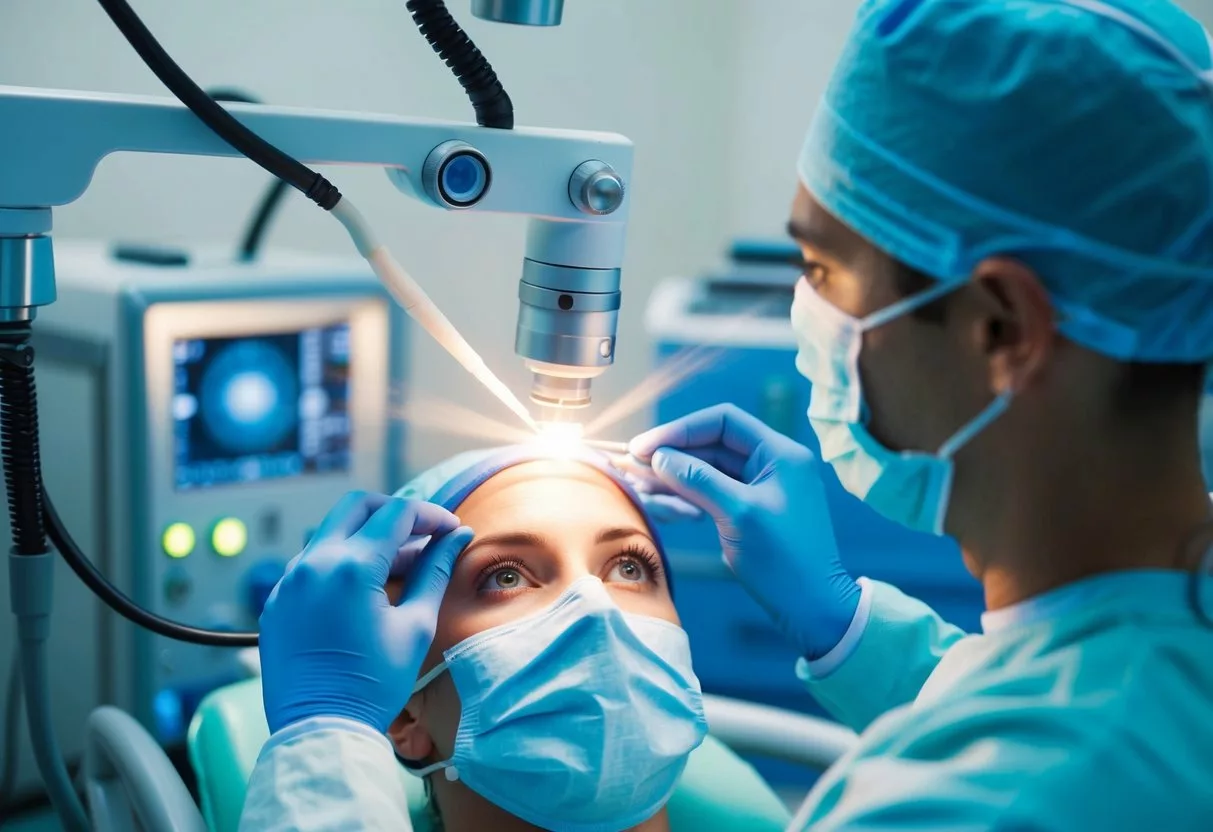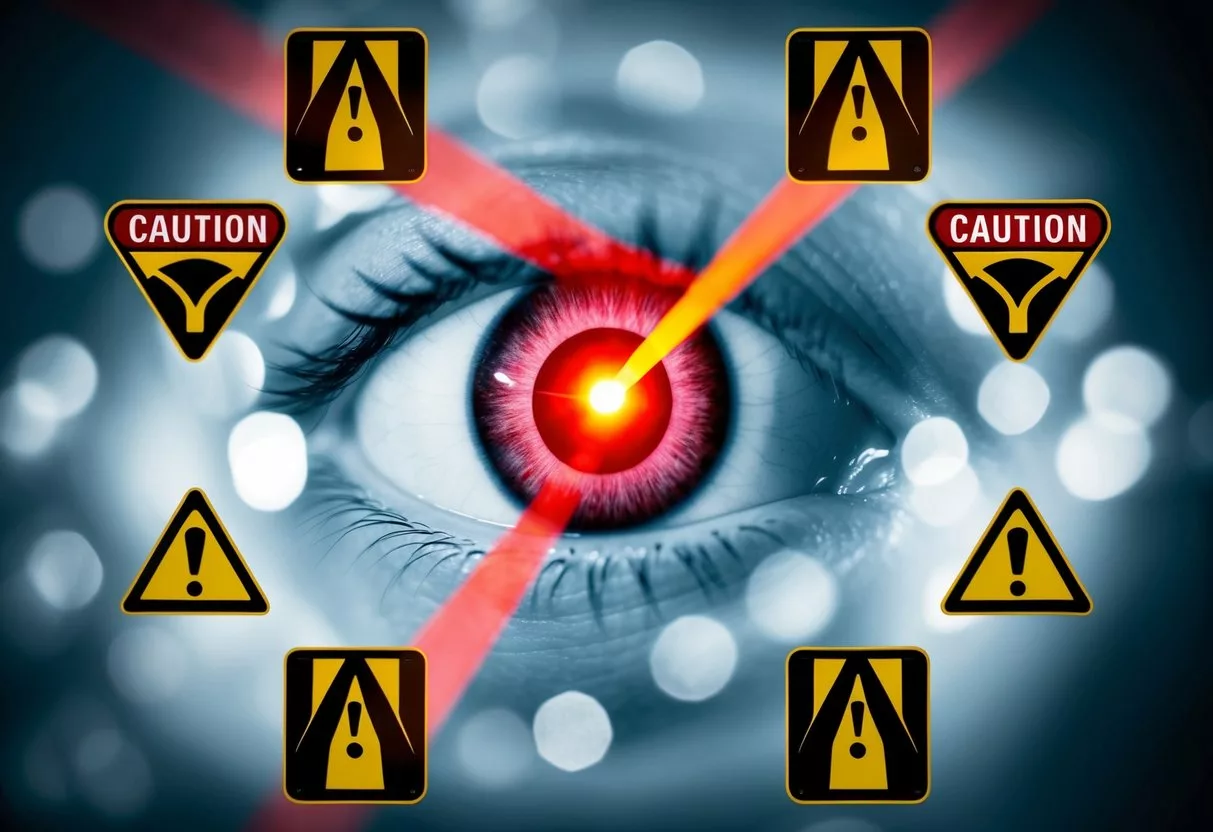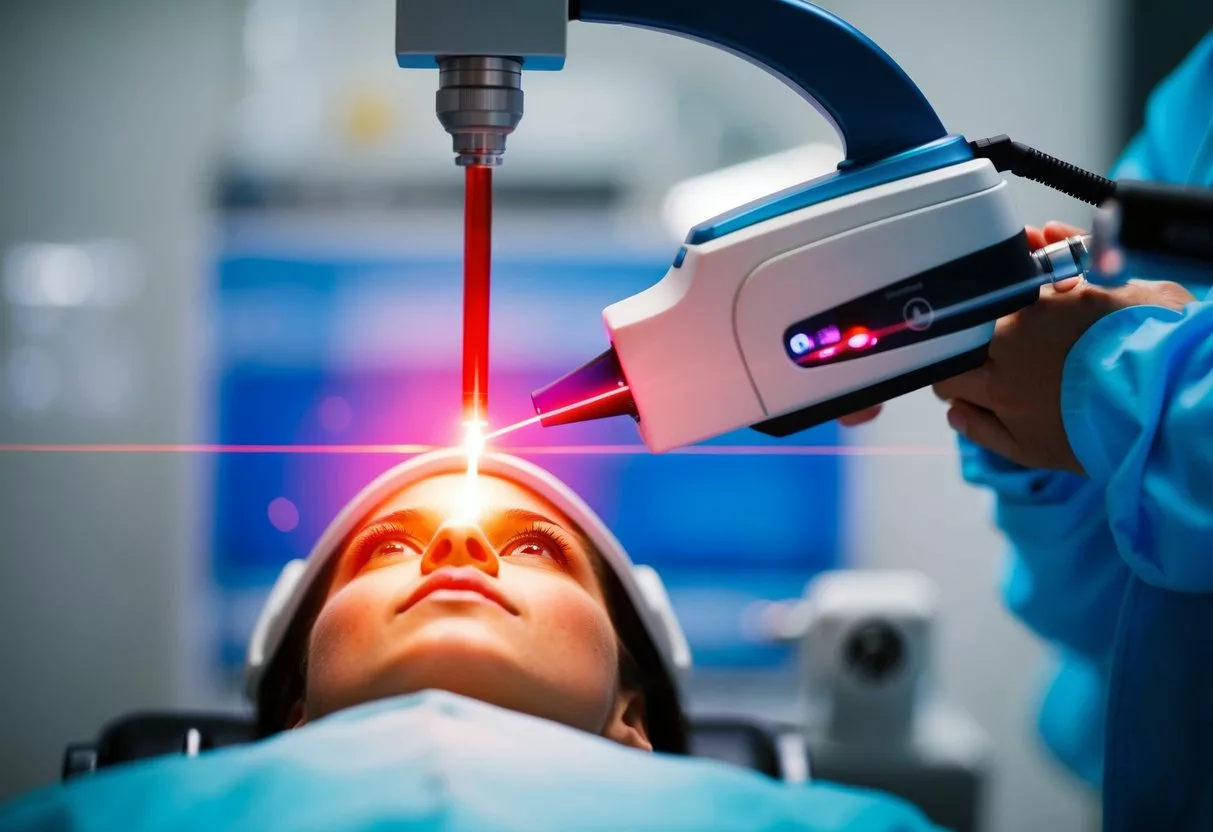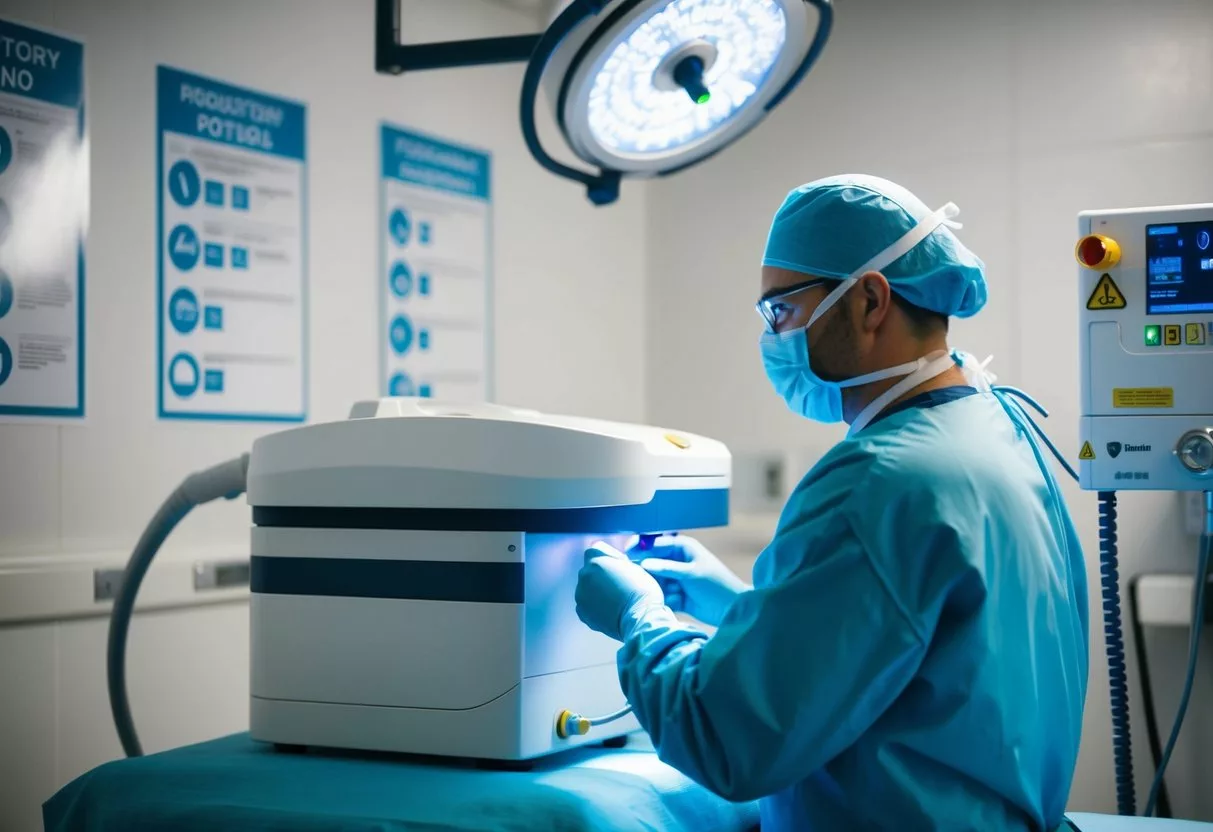Laser eye surgery has become a popular choice for people looking to improve their vision. This procedure uses lasers to reshape the cornea, helping to correct common vision problems like nearsightedness, farsightedness, and astigmatism.
Laser eye surgery can often reduce or eliminate the need for glasses or contact lenses. This offers many patients clearer vision without corrective lenses.

The most common type of laser eye surgery is LASIK. During LASIK, a surgeon creates a thin flap in the cornea and uses a laser to reshape the underlying tissue. This quick procedure typically takes less than 30 minutes for both eyes. Most people notice improved vision within 24 hours after surgery.
While laser eye surgery can be life-changing for many, it’s not suitable for everyone. People with certain eye conditions or health issues may not be good candidates. It’s important to have a thorough eye exam and discuss the risks and benefits with an eye doctor before deciding if laser eye surgery is right for you.
Understanding Laser Eye Surgery
Laser eye surgery reshapes the cornea to correct vision problems. It uses precise laser technology to improve focus and reduce dependence on glasses or contacts.
Types of Laser Eye Surgery
LASIK is the most common type of laser eye surgery. It involves creating a thin flap in the cornea before reshaping the underlying tissue.
PRK is an older method that removes the outer corneal layer before reshaping. It may be better for those with thin corneas.
LASEK is similar to PRK but preserves the outer corneal layer. This can lead to faster healing for some patients.
SMILE is a newer technique. It uses a laser to create a small lens-shaped bit of tissue within the cornea, which is then removed through a tiny incision.
The Science Behind the Procedure
Laser eye surgery works by changing the shape of the cornea. This clear, dome-shaped tissue at the front of the eye bends light as it enters.
In people with vision problems, the cornea doesn’t bend light correctly. This causes blurry vision.
The laser removes tiny amounts of tissue from the cornea. This changes its shape so it can focus light properly onto the retina at the back of the eye.
Different lasers are used for different steps. An excimer laser reshapes the cornea, while a femtosecond laser creates the corneal flap in LASIK.
Comparing LASIK, PRK, LASEK, and SMILE
LASIK offers quick recovery and little discomfort. Most people see clearly within 24 hours.
PRK has a longer recovery time. It may be better for those with thin corneas or dry eyes.
LASEK combines elements of LASIK and PRK. It may reduce the risk of certain complications.
SMILE is less invasive than LASIK. It may lead to fewer dry eye symptoms.
All these methods can treat nearsightedness, farsightedness, and astigmatism. The best choice depends on your eye health and vision needs.
Your eye doctor can help you decide which type is right for you.
Who Is Eligible for Laser Eye Surgery?
Laser eye surgery can correct many vision problems, but not everyone is a good candidate. Eligibility depends on eye health, type of vision issue, age, and other factors. Let’s look at the key criteria doctors use to determine if someone can have laser eye surgery.
Eye Health Assessment
A thorough eye exam is crucial before laser surgery. The doctor checks for eye diseases or conditions that could affect the outcome. They look at corneal thickness, as the cornea must be thick enough to safely create the corneal flap. Patients with dry eyes may need treatment before surgery.
Eye pressure is measured to rule out glaucoma. The doctor also dilates the pupils to examine the retina and optic nerve. Any issues found during this exam could make someone ineligible for laser surgery.
Refractive Error Criteria
Laser eye surgery can fix nearsightedness, farsightedness, and astigmatism. But there are limits to how much correction it can provide.
For nearsightedness, the prescription should be stable for at least a year. Most surgeons can treat up to -12 diopters. Farsightedness can usually be corrected up to +6 diopters, while astigmatism correction is often limited to 6 diopters.
People with very high prescriptions or irregular astigmatism may not qualify. The doctor will determine if the degree of refractive error falls within treatable ranges.
Age and Lifestyle Considerations
Age plays a role in eligibility for laser eye surgery. Patients must be at least 18 years old, but many doctors prefer to wait until the mid-20s when vision stabilizes. There’s no upper age limit, but older adults may have other eye issues that make them poor candidates.
Certain jobs or hobbies can affect eligibility. Contact sports that risk eye injury may not be compatible with laser surgery. Pregnancy and nursing can cause vision changes, so women should wait until a few months after weaning.
Some health conditions like diabetes or autoimmune diseases may disqualify a person. The doctor will review medical history to ensure laser surgery is safe for each patient.
Benefits of Laser Eye Surgery

Laser eye surgery offers several advantages for people with vision problems. It can improve eyesight, reduce reliance on glasses or contacts, and enhance quality of life.
Long-Term Vision Improvement
Laser eye surgery can correct vision problems like nearsightedness, farsightedness, and astigmatism. Many patients achieve 20/20 vision or better after the procedure.
The results are often long-lasting. Most people maintain improved vision for many years after surgery. Some may need a touch-up procedure later in life as their eyes change with age.
Laser surgery reshapes the cornea, allowing light to focus properly on the retina. This can lead to clearer, sharper vision without corrective lenses.
Reduced Dependence on Corrective Lenses
One of the main benefits of laser eye surgery is less need for glasses or contacts. Many patients no longer need to wear corrective lenses for most daily activities.
This can be especially helpful for:
- Athletes
- People with active lifestyles
- Those who find glasses or contacts uncomfortable
Some patients may still need reading glasses as they age due to presbyopia. But their overall dependence on corrective lenses is often greatly reduced.
Lifestyle Enhancements
Laser eye surgery can improve many aspects of daily life. Patients often report:
- Easier participation in sports and outdoor activities
- Improved night vision for driving
- No more hassle with glasses or contact lenses
- Increased self-confidence
The surgery can be particularly beneficial for people in certain professions. Police officers, firefighters, and military personnel may perform their jobs more effectively with improved vision.
Many patients feel a sense of freedom after no longer needing corrective lenses. This can lead to a better quality of life and more enjoyment of daily activities.
Risks and Side Effects

Laser eye surgery comes with potential risks and side effects. While many people experience positive outcomes, it’s important to be aware of possible issues that can occur during recovery or long-term.
Common Post-Operative Symptoms
After laser eye surgery, some temporary side effects are normal. Many patients feel mild discomfort or a gritty sensation in their eyes. This usually goes away within a few days.
Dry eyes are very common. Artificial tears can help manage this symptom. Light sensitivity may occur, so wearing sunglasses is recommended.
Some people see halos or glare around lights, especially at night. This often improves over time as the eyes heal.
Blurry or fluctuating vision is also normal at first. It can take several weeks for vision to fully stabilize.
Potential Complications
While rare, more serious complications can happen with laser eye surgery. These include:
- Vision loss or permanent changes to vision
- Undercorrection or overcorrection of vision problems
- Astigmatism
- Dry eye syndrome that doesn’t resolve
- Eye infections
Problems with the corneal flap are possible too. The flap may not heal properly or could become displaced.
In very rare cases, some patients develop chronic pain or discomfort in their eyes.
Managing Expectations
It’s crucial to have realistic expectations about laser eye surgery results. Not everyone achieves perfect 20/20 vision.
Some people still need glasses for certain activities, like reading or driving at night. Others may develop presbyopia as they age, requiring reading glasses.
The effects of laser eye surgery can diminish over time for some patients. Follow-up procedures may be needed years later.
It’s important to follow all post-operative instructions carefully. This helps reduce risks and promotes proper healing.
Patients should attend all follow-up appointments. Any new or worsening symptoms should be reported to the eye doctor right away.
The Procedure Explained
Laser eye surgery involves precise steps to reshape the cornea and improve vision. The process includes careful preparation, the surgery itself, and proper aftercare to ensure optimal results.
Pre-Operative Preparations
Before LASIK surgery, patients undergo thorough eye exams. These tests measure corneal thickness, pupil size, and eye moisture. Doctors create detailed maps of the eyes.
Patients must stop wearing contact lenses weeks before surgery. This allows the cornea to return to its natural shape.
The day before surgery, patients should:
- Clean eyelashes thoroughly
- Avoid makeup, lotions, or perfumes
- Arrange transportation home
- Get a good night’s sleep
During the Surgery
The actual LASIK procedure takes about 15 minutes per eye. Patients receive numbing eye drops for comfort.
A device holds the eyelids open. The surgeon creates a thin flap in the cornea using either a microkeratome blade or a femtosecond laser.
The flap is folded back, exposing the inner corneal tissue. An excimer laser then reshapes the cornea. The flap is repositioned, acting as a natural bandage.
Post-Operative Care
After surgery, patients rest for a short time. They then go home wearing protective shields over their eyes.
Vision may be blurry at first. Most people see clearly within 24 hours. Full recovery takes a few weeks to months.
Post-op instructions include:
- Using prescribed eye drops
- Avoiding rubbing eyes
- Wearing eye shields while sleeping
- Staying out of pools and hot tubs
- Avoiding strenuous activity
Follow-up appointments check healing progress. Most people return to work within a day or two.
Life After Laser Eye Surgery

Laser eye surgery can greatly improve vision and reduce dependence on glasses or contacts. Patients often experience significant changes in their eyesight and daily routines after the procedure.
Visual Acuity and Adjustment
Most people notice improved vision within 24 hours after surgery. Colors may appear brighter and sharper. Some patients report better night vision.
Adjusting to new vision takes time. Blurry vision or fluctuations in clarity are normal in the first few weeks. Eyes may feel dry or irritated initially.
It’s important to follow the doctor’s instructions for eye drops and rest. Avoiding rubbing the eyes helps prevent complications.
Patients should wait before driving until cleared by their doctor. Most can return to work within a few days, depending on their job.
Follow-Up Examinations
Regular check-ups are crucial after laser eye surgery. The first follow-up usually occurs within 24-48 hours.
Additional appointments are typically scheduled at: – 1 week – 1 month – 3 months – 6 months – 1 year
During these visits, doctors check: – Vision clarity – Eye pressure – Healing progress – Any side effects
Patients should report any vision changes or discomfort between appointments. Prompt attention to issues helps ensure the best outcomes.
Possibility of Enhancement Procedures
Sometimes, initial results don’t meet expectations. In these cases, enhancement procedures may be recommended.
Enhancements are typically done 3-6 months after the original surgery. They fine-tune results for optimal vision.
Not everyone needs an enhancement. Factors that may lead to one include: – Initial undercorrection or overcorrection – Regression of vision improvements – Astigmatism changes
The decision for an enhancement depends on: – Stability of vision – Eye health – Patient’s visual needs
Doctors carefully evaluate each case before recommending further treatment. The goal is to achieve the best possible vision for each patient.
Financial Considerations

Laser eye surgery involves important financial factors to weigh. The cost can vary widely, and there are different payment options to consider. Many find the procedure to be a worthwhile investment in their vision and quality of life.
Determining the Cost of LASIK
The price of LASIK surgery typically ranges from $1,500 to $3,000 per eye. Factors that affect the cost include:
• The surgeon’s experience
• The technology used
• Your location
• The complexity of your prescription
Some clinics offer package deals that include pre-operative exams and follow-up care. It’s wise to get quotes from multiple providers and ask what’s included in the price.
Be wary of extremely low-cost offers, as they may indicate outdated technology or hidden fees. The cheapest option isn’t always the best value for your eye health.
Insurance and Payment Options
Most health insurance plans don’t cover LASIK, as it’s seen as an elective procedure. But there are ways to make it more affordable:
• Flexible Spending Accounts (FSAs) let you use pre-tax dollars for medical expenses. • Health Savings Accounts (HSAs) work similarly to FSAs. • Some clinics offer financing plans with low or zero interest. • A few insurance plans may cover part of the cost if you have certain eye conditions.
It’s smart to check with your insurance provider about any vision-related benefits. Some offer discounts on LASIK through partner clinics.
Calculating Return on Investment
To figure out if LASIK is worth the cost, consider:
• The money you’ll save on glasses, contacts, and eye care products
• The value of improved vision in your daily life and work
• The time saved on eye care routines
For example, if you spend $500 yearly on contacts and solutions, LASIK could pay for itself in 6-12 years. But the benefits often go beyond money.
Many patients report higher job satisfaction and better performance in sports. The convenience of not needing glasses or contacts can be life-changing for some people.
Alternative Procedures and Treatments

Not everyone can have laser eye surgery. Some people need different options to fix their vision. Let’s look at other ways to improve eyesight without lasers.
When Laser Eye Surgery Isn’t an Option
Some people can’t get laser eye surgery. Thin corneas and keratoconus can rule out LASIK. Eye injuries may also prevent laser treatment. Contact sports players often can’t get LASIK due to risks.
For these cases, there are other choices. Photorefractive keratectomy (PRK) is one option. It reshapes the cornea without making a flap. This can work for thin corneas.
Another choice is implantable contact lenses (ICL). These are put inside the eye to correct vision. They don’t change the cornea, so they’re good for some eye conditions.
Cataract Surgery and Other Interventions
Cataracts cloud the eye’s lens and cause vision loss. Cataract surgery replaces the cloudy lens with a clear artificial one. This can also fix other vision problems.
During cataract surgery, special lenses can be used. These include:
- Multifocal lenses for near and far vision – Toric lenses to correct astigmatism
For some, refractive lens exchange is an option. It’s like cataract surgery but done before cataracts form. This can fix severe nearsightedness or farsightedness.
SMILE (Small Incision Lenticule Extraction) is a newer laser procedure. It uses a small cut to reshape the cornea. This may be better for dry eyes than LASIK.
Safety and Regulatory Overview

Laser eye surgery has strict safety protocols and regulations. These cover FDA approval of devices and procedures, as well as quality standards for surgeons and facilities.
FDA Regulations and Approval
The FDA regulates laser devices used in eye surgery. Before a laser can be sold in the U.S., it must get FDA approval. This process involves reviewing safety and effectiveness data.
The FDA also monitors lasers after approval. They track problems and can issue recalls if needed. Surgeons must report serious issues to the FDA.
Different eye conditions need different types of lasers. The FDA approves each laser for specific uses. Using a laser for an unapproved purpose is risky and often not allowed.
Quality and Safety Standards
Eye surgery centers must follow strict safety rules. These cover things like:
- Sterilization of equipment – Proper laser maintenance – Staff training – Emergency procedures
The American National Standards Institute sets guidelines for laser use in healthcare. These rules help protect patients and staff.
Many centers have a Laser Safety Officer. This person makes sure all safety rules are followed. They also train staff on laser risks and safety measures.
Surgeons need special training to use lasers safely. They must keep learning about new techniques and safety updates. Regular practice reviews help maintain high standards of care.
Questions to Ask Your Surgeon
Before laser eye surgery, it’s crucial to have an open discussion with your surgeon. Ask about their experience, the procedure details, and what to expect before and after the operation.
Pre-Surgery Consultation
During your first meeting, ask about the surgeon’s qualifications and experience. Find out how many similar procedures they’ve done.
Ask if you’re a good candidate for laser eye surgery. The surgeon will need to do a thorough eye exam to check your vision and eye health.
Discuss the type of laser technology they’ll use. Ask about the success rates for your specific vision problem.
It’s important to understand the costs involved. Ask about the total price, including any follow-up care or additional treatments.
Understanding the Risks
Every surgery has risks, so ask about potential complications. Common side effects can include dry eyes, glare, and temporary vision changes.
Ask about the chances of needing a second surgery. Some people may need touch-ups to get the best results.
Discuss how the surgery might affect your night vision. Some patients experience halos or glare around lights after the procedure.
Find out if the surgery could impact your future eye health. Ask if it might make it harder to detect other eye problems later on.
Post-Surgery Expectations
Ask about the expected recovery time. Most people can return to work within a few days, but full healing can take weeks.
Discuss how soon you can expect to see improvements in your vision. Results can vary from person to person.
Ask about post-surgery care. You’ll need to know how to protect your eyes and what activities to avoid.
Find out about follow-up appointments. Regular check-ups are important to monitor your healing and vision changes.
Ask what to do if you have concerns after surgery. Make sure you know who to contact if you experience any problems.
Frequently Asked Questions
Laser eye surgery involves important considerations regarding risks, recovery, procedure duration, pain levels, long-term effects, and lasting results. Patients often have specific concerns about these aspects of the treatment.
What are the potential risks involved with laser eye surgery?
Laser eye surgery carries some risks. These can include dry eyes, glare, and halos around lights. In rare cases, patients may experience vision loss or changes.
LASIK surgery can also lead to under-correction or over-correction of vision. This might require additional procedures to achieve the desired outcome.
What can I expect during the recovery period after laser eye surgery?
Recovery from laser eye surgery is usually quick. Most people return to normal activities within a day or two. Vision typically improves rapidly, but full stabilization can take a few weeks.
Patients may experience some discomfort or mild pain immediately after the procedure. Eyes might feel itchy or burn for a short time.
How long is the typical duration of a laser eye surgery procedure?
Laser eye surgery is a relatively quick procedure. The actual laser treatment often takes less than a minute per eye. The entire process, including preparation, usually lasts about 30 minutes.
Does laser eye surgery cause any pain during or after the procedure?
Laser eye surgery is generally not painful during the procedure. Surgeons use numbing eye drops to ensure comfort. After surgery, some patients may feel mild discomfort or a sensation of something in the eye.
This feeling typically subsides within a few hours or days. Pain medication is rarely needed, but doctors may recommend over-the-counter options if necessary.
What are the possible long-term side effects of laser eye surgery?
Long-term side effects of laser eye surgery are uncommon but can occur. Some patients may experience persistent dry eyes or difficulty with night vision. In rare cases, vision problems like halos or glare may persist.
It’s important to discuss potential risks and benefits with an ophthalmologist before deciding on the procedure.
How long can the visual improvement from laser eye surgery be expected to last?
For many patients, the visual improvement from laser eye surgery can last a lifetime. However, natural age-related changes in vision may still occur over time.
Some people might need reading glasses as they age, even after laser eye surgery. Regular eye check-ups are important to monitor long-term eye health and vision quality.